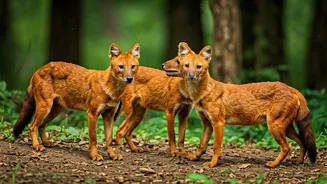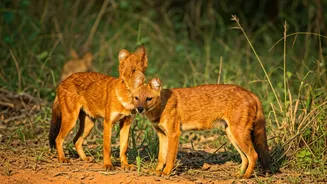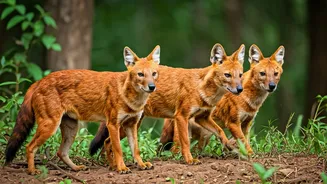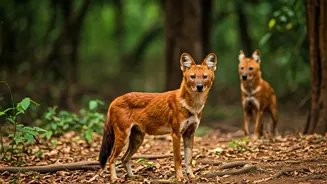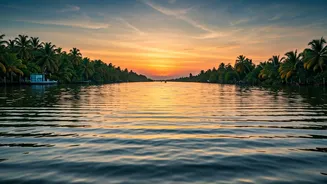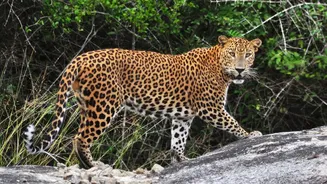Introduction to Dholes
Dholes, scientifically known as Cuon alpinus, are native to Central, South, and Southeast Asia. These wild canids are a critical part of their ecosystems,
playing an important role in regulating prey populations. They are highly social animals, living and hunting in packs with a complex social structure. Unfortunately, habitat loss, prey scarcity, and persecution by humans have significantly impacted dhole populations, leading to their classification as an endangered species. Conservation efforts focus on protecting their habitats, controlling poaching, and mitigating human-wildlife conflict to ensure their survival.
Kanha National Park
Kanha National Park, located in Madhya Pradesh, is a key habitat for dholes. It is well-known for its abundant wildlife, including tigers, leopards, and various species of deer. The park's diverse terrain, encompassing grasslands, plateaus, and dense forests, offers a suitable environment for dholes to thrive. Conservation programs in Kanha are focused on protecting the park's natural resources and reducing the threats faced by dholes, such as habitat fragmentation and poaching. The park's management also works closely with local communities to promote wildlife conservation through education and sustainable practices.
Bandhavgarh National Park
Also situated in Madhya Pradesh, Bandhavgarh National Park is another crucial area for dhole conservation. It is celebrated for its high tiger density and rich biodiversity, providing a suitable ecosystem for dholes. The park's undulating terrain, interspersed with rocky hills and grasslands, offers optimal conditions for the canines' hunting and social behaviors. Conservation efforts are aimed at minimizing human-wildlife conflict and protecting their prey base. The local authorities have implemented various strategies to manage tourism and maintain the delicate ecological balance necessary for the dholes to survive and flourish.
Jim Corbett National Park
Jim Corbett National Park, in Uttarakhand, is India's oldest national park and a significant site for dhole conservation. This park's diverse landscape, featuring valleys, hills, and riverine habitats, supports a wide array of wildlife, including tigers, elephants, and a healthy dhole population. Conservation programs emphasize anti-poaching measures, habitat preservation, and community involvement. It also promotes responsible tourism to ensure the protection of the dholes and their environment.
Nagarahole National Park
Nagarahole National Park, located in Karnataka, is well-known for its substantial wildlife population, including a significant presence of dholes. The park’s lush forests, coupled with its strategic location within the Western Ghats, make it an ideal habitat for these wild dogs. Conservation efforts within Nagarahole focus on maintaining the ecological integrity of the park through habitat management and minimizing human impacts. The authorities continuously monitor the dhole population to understand their behavior, health, and how to improve their survival within the ecosystem.
Periyar National Park
Periyar National Park, in Kerala, is known for its diverse wildlife and conservation efforts, including the protection of dholes. The park's environment, marked by dense evergreen forests and scenic water bodies, offers an exceptional habitat for dholes, as well as elephants and tigers. The conservation initiatives focus on habitat restoration, community outreach, and controlling human activities that might threaten the local ecology. The authorities actively monitor the dhole populations and continuously improve the strategies to enhance the dholes' ability to live and reproduce within the ecosystem.


